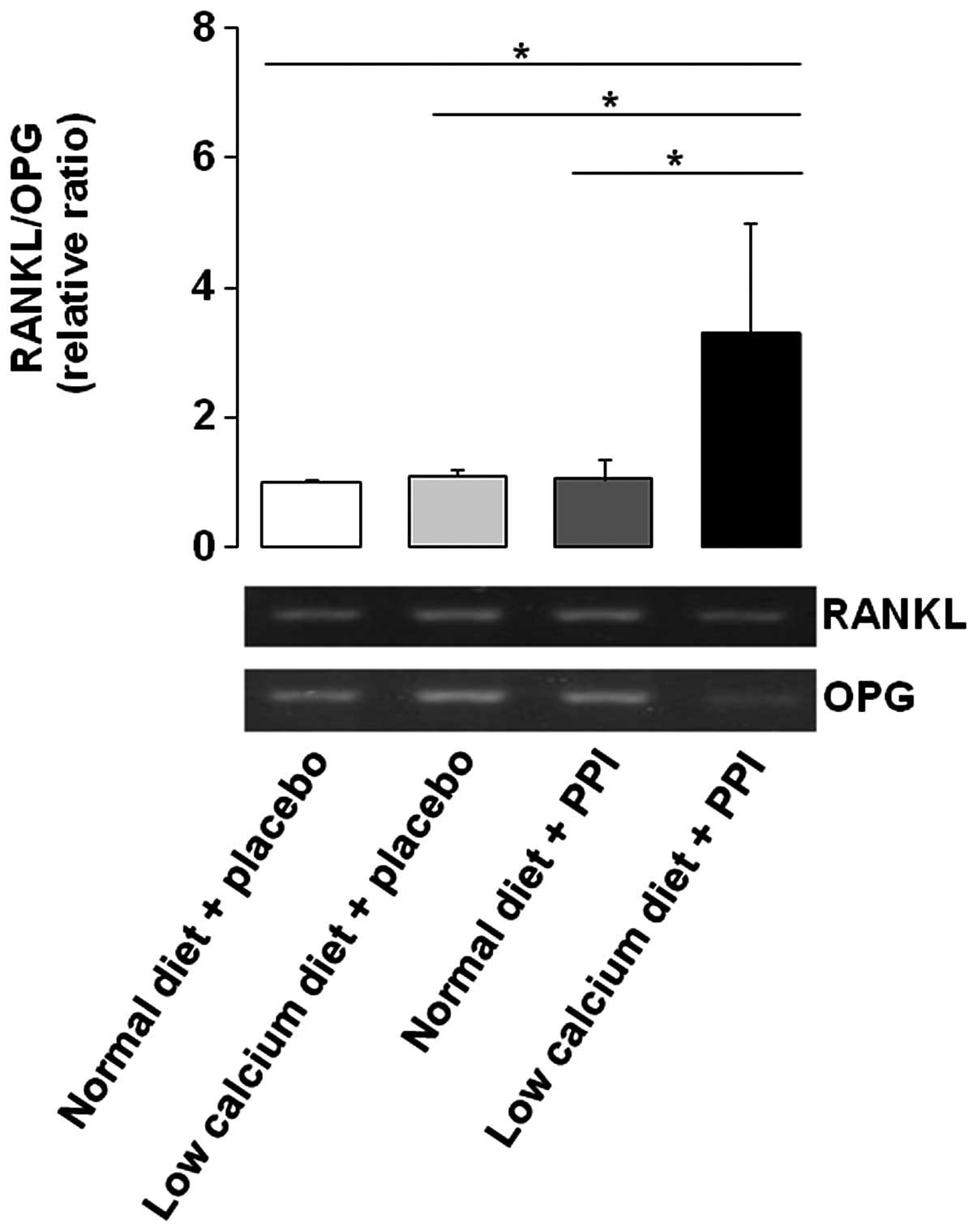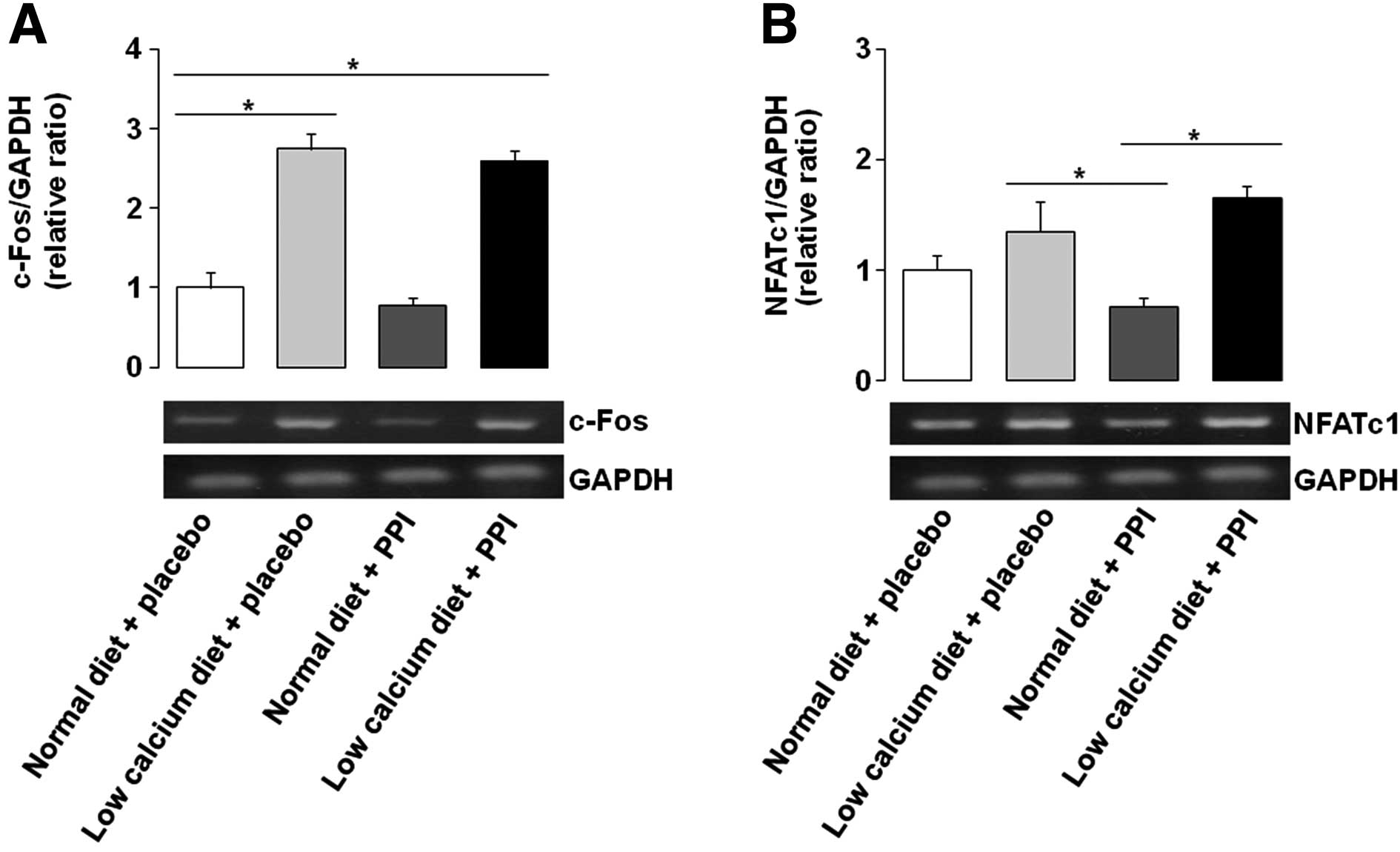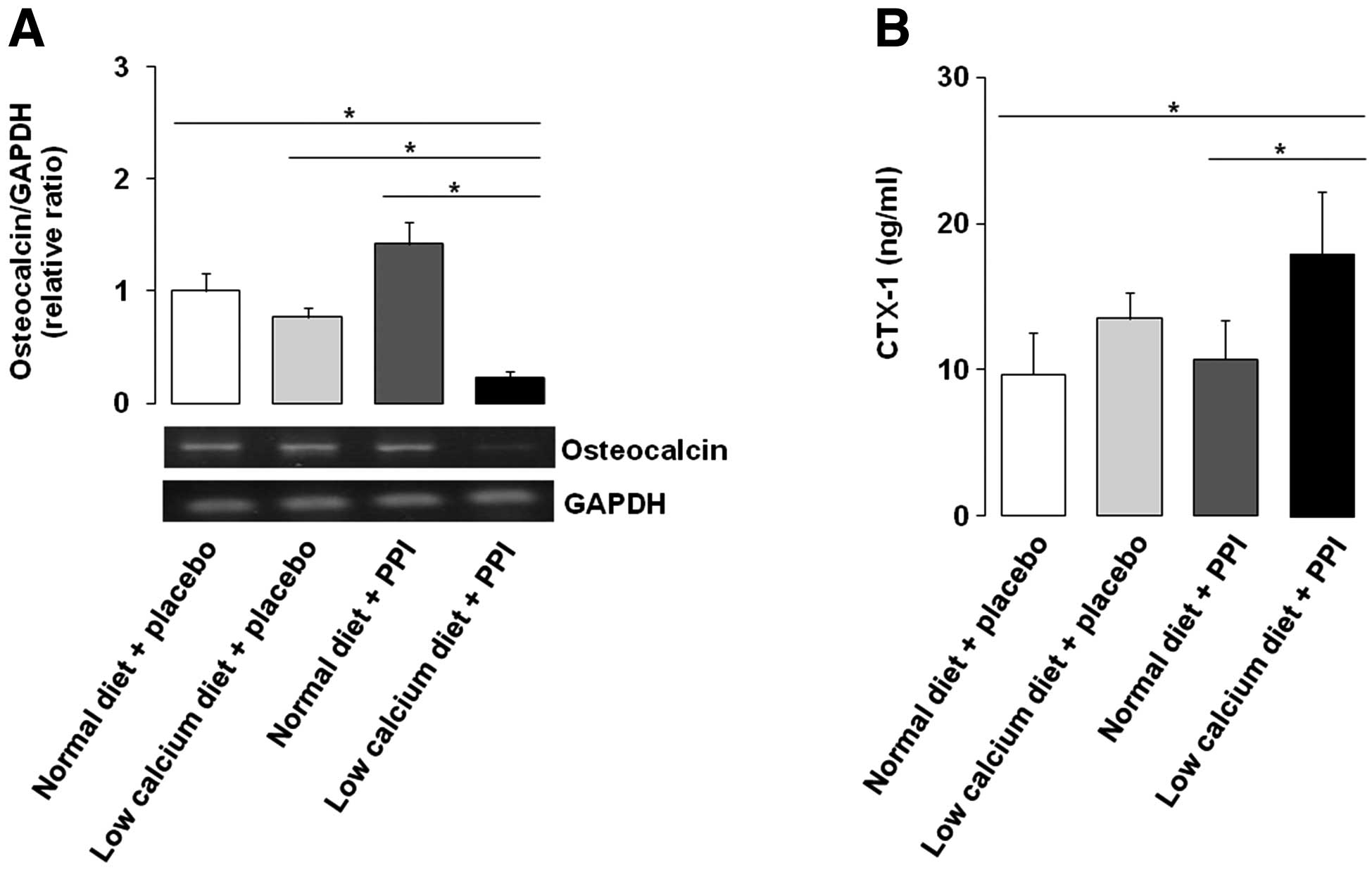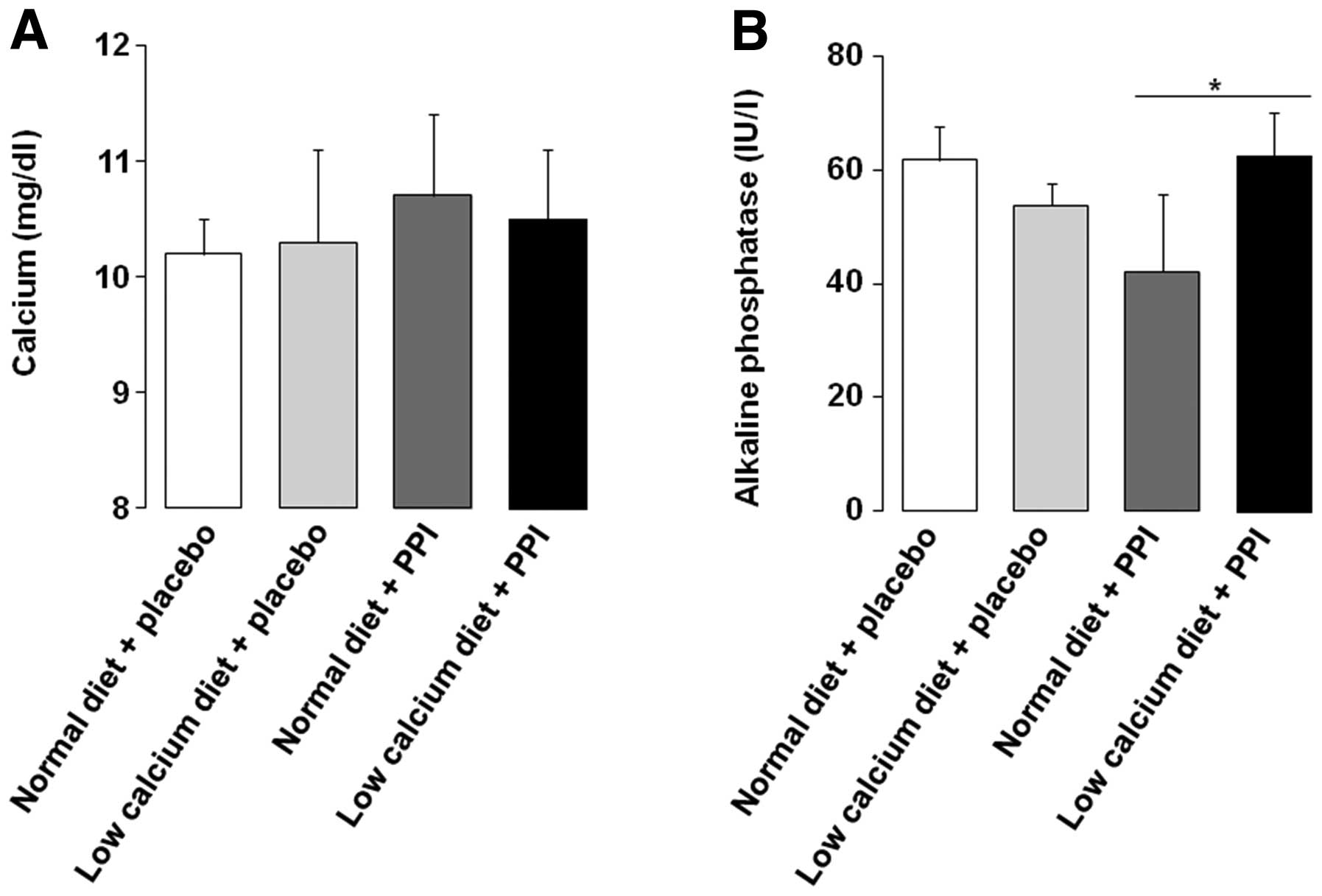The effect of a proton pump inhibitor on bone metabolism in ovariectomized rats
- Authors:
- Published online on: February 19, 2013 https://doi.org/10.3892/mmr.2013.1327
- Pages: 1267-1272
Abstract
Introduction
Gastroesophageal reflux disorder (GERD) is a common disease worldwide, whose prevalence has been on the increase in Eastern Asia in addition to Western countries (1). Accordingly, the prescription of proton pump inhibitors (PPIs) is increasing rapidly (2–5). Long-term PPI therapy has been established as a standard treatment strategy to manage refractory GERD, which has not responded to the standard dose, or recurrent GERD after the withdrawal of PPI treatment (6,7). PPIs have been known to be safe drugs without any major complications with long-term use (8). However, a large-scale epidemiologic study reported that high-dose, long-term therapy with PPIs significantly increased the risk of osteoporosis and pathologic hip fracture (9). A previous nested case-control study revealed that more than one year of PPI therapy is associated with increased risk of hip or femur fracture (10). However, there have been few studies undertaken to clarify the exact mechanism of the PPI effect. It has been established that PPIs reduce the production and secretion of hydrochloric acid in the human stomach, increase the pH in the stomach or small intestine and inhibit absorption of insoluble calcium in the small intestine, thus leading to pathologic fractures (11,12). Alternatively, several in vitro studies have reported that PPIs inhibit the vacuolar-ATPase (V-ATPase) of osteoclasts and reduce their activity (13,14). Clinical studies have supported the theory that the short-term use of PPI in children or adults does not alter or reduce bone resorption markers (15,16). There are conflicting data regarding the effect of PPI on bone metabolism, however, little is known about the long-term effect of PPI on osteoclast or bone resorption in human or animal models.
Receptor activator of NF-κB ligand (RANKL), its receptor RANK, and its decoy receptor osteoprotegerin (OPG) are novel concepts in bone metabolism (17). RANKL, a member of the tumor necrosis factor (TNF) family, is a membrane-bound cytokine, and is bound to RANK, a homotrimeric transmembrane protein member of the TNF receptor superfamily, and is expressed on the surface of the osteoclast precursor (OCP). RANKL/RANK binding differentiates the OCP, induces formation, differentiation and activation of osteoclasts, and acts as an essential stimulator for bone resorption. By contrast, OPG is known to inhibit differentiation and activation of osteoclasts effectively under in vivo or in vitro conditions (18,19). As a result, regulation of RANKL or OPG expression is crucial in bone metabolism, and the RANKL/OPG ratio changes in favor of abnormal osteoclastogenesis and is known as a predictive risk factor for pathologic fractures (20,21). Furthermore, sequential activation of c-Fos and the nuclear factor of activated T cell c1 (NFATc1) by the RANKL/RANK/NF-κB signaling system is essential for the completion of the differentiation process of the OCP and osteoclasts (22–24).
We performed a pilot animal study using ovariectomized ICR mice, into which we injected pantoprazole via an intraperitoneal route, and observed that messenger RNA (mRNA) expression levels of IL-1β were inhibited significantly in the pantoprazole group compared with the control group. No significant difference was observed in the bone marrow density (BMD) between the two groups, from which we hypothesized that the ingestion of PPI can affect bone resorption and bone metabolism (25). In the present study, we aimed to evaluate the long-term effect of PPIs on bone resorption and remodeling in an ovariectomized rat model by analyzing the RANKL/OPG ratio, c-Fos, NFATc1 and osteocalcin, a well-known bone formation biochemical marker, by using bone marrow cells and serum C-terminal cross-linking telopeptide of type I (CTX-1), as a bone resorption marker.
Materials and methods
Experimental animals
Five-week-old female Sprague-Dawley (S-D) rats were housed for one week for preparatory adaptation to the new environment, ovariectomized at 6 weeks old and allowed to adapt to the inflammatory process for 2 weeks. All the rats were maintained in a laboratory at a temperature of 23±1°C and humidity of 55±5% under a 12-h light-dark cycle (light 7:00–19:00). At 8 weeks old, the animals were subdivided equally into 4 groups. The rats were fed on a regular diet with placebo (group A), low calcium diet with placebo (group B), regular diet with PPI (group C) and low calcium diet with PPI (group D). Solid feed was used for the rats including calcium 1.25%, phosphorus 0.95%, vitamin D 340 IU/100 mg (Samyang Co., Ltd., Seoul, Korea) as the regular diet, and another solid rat feed including calcium 0.01%, phosphorus 0.95%, vitamin D 340 IU/100 mg (Oriental Yeast Co., Ltd., Tokyo, Japan) for the low calcium diet. Omeprazole was administered orally at a dose of 30 mg/kg/day. The above diets and drugs were fed throughout the 8 weeks. At 16 weeks old, the rats were euthanized under general anesthesia. This study was approved by the Korea University Institute of Animal Care and Use Committee.
Reverse transcriptase-polymerase chain reaction
Bone marrow cells were collected from the femurs of the S-D rats. After washing with PBS three times, the cells were diluted with a 1 ml solution including 50 mM HEPES (pH 7.0), 150 mM NaCl, 1.5 mM MgCl, 1% Triton, 10 mM sodium pyrophosphate, 1 mM PMSF (Sigma-Aldrich, St. Louis, MO, USA) and 10 μg/ml leupeptin (Sigma-Aldrich). After mixing and centrifugation with 500 μl TRIzol solution (Invitrogen, Grand Island, NY, USA) and 100 μl chloroform, supernatants from the acquired cell extracts were used for the reverse transcriptase-polymerase chain reaction (RT-PCR). After washing the supernatants with 75% ethanol, the total RNA was extracted, and the reaction mixture composed of 10X reverse transcription buffer, RNase inhibitor, dNTP, M-MLV reverse transcriptase and 1 μl total RNA was incubated at 42°C for 15 min to synthesize cDNA. The cDNA produced was amplified into PCR using sense/antisense primers (Table I). The resulting product was dissolved in 2% agarose gel, dyed with ethidium bromide and developed under UV light. To qualify the reactants, the band was measured using densitometry and each ratio to GAPDH was calculated.
Measurement of serum CTX-1
After sacrificing the experimental S-D rats, their blood was sampled from the right atrium. Serum was produced by centrifugation of the collected blood. An immunoassay kit (RatLaps™, ImmunoDiagnostic Systems, Herlev, Denmark) was used for the measurement of CTX-1. In brief, 100 μl of biotinylated RatLaps antigen (Ag biotin) was added to each well, incubated for 30±5 min at room temperature, the immuno strips were washed manually five times using 300 μl of washing solution (wash buffer) and 20 μl serum samples were added from each group into the appropriate wells followed by 100 μl of primary antibody. Samples were incubated overnight (18±3 h) at 2–8°C and washed a further five times. Following the addition of 100 μl of peroxidase-conjugated goat anti-rabbit IgG antibody (enzyme conjugate) to each well, samples were incubated for 60±5 min at room temperature,100 μl of substrate solution was added to each well and incubated for 15±2 min at room temperature in the dark and 100 μl of stopping solution was then added to each well. Finally, the absorbance was measured within 2 h at 450 nm, with a reading at 650 nm acting as a reference.
Measurement of serum calcium and alkaline phosphatase levels
Whole blood was collected and serum was obtained using the same method as that mentioned previously. Serum levels of calcium and alkaline phosphatase (ALP) were measured by activity analysis using a reagent (ELITech™, Provence, France).
Statistical analysis
SPSS for Windows (version 12.0, SPSS, Inc., Chicago, IL, USA) was used as the statistical analysis program. Continuous variables were analyzed using ANOVA when the variables followed a normal distribution, and the Kruskal-Wallis test (a non-parametric method) when they did not follow a normal distribution. P<0.05 was considered to indicate a statistically significant difference.
Results
RANKL/OPG ratio is increased by the combination of a low calcium diet and PPI
To evaluate the relative ratio of RANKL/OPG, the RT-PCR method was performed. Initially, the gene expression level of RANKL was upregulated by low calcium diet alone and PPI alone, compared with normal diet alone. Expression levels of OPG were also upregulated by PPI alone, compared to that of normal diet alone, which showed a similar pattern to RANKL. However, OPG was markedly downregulated by a low calcium diet with PPI. Consequently, the RANKL/OPG ratio was significantly increased by a low calcium diet with PPI, compared to the other three groups (Fig. 1). Given that OPG binds competitively to RANKL to inhibit RANKL-RANK binding, if the administration of PPI is combined with a low calcium diet, it may enhance the signal transduction through RANK.
Gene expression of c-Fos and NFATc1 is upregulated by low calcium diet with or without PPI
Relative mRNA expression levels of c-Fos, a transcription factor of the RANKL/RANK/NF-κB signaling pathway, was also measured by the RT-PCR method. C-Fos levels were increased by a low calcium diet with or without PPI, compared with that of a normal diet alone, by 131 and 115%, respectively (Fig. 2A). NFATc1 is a target gene for c-Fos activation, and showed a similar pattern for c-Fos expression, which was increased by a low calcium diet with or without PPI, compared with that of PPI alone, by 87 and 107%, respectively (Fig. 2B). When considered together with the RANKL/OPG ratio, it is suggested that PPI alone may not cause differentiation and activation of osteoclasts, as the autoamplification of NFATc1 mediates completion of the differentiation process as the final step to several signaling pathways (20).
Osteocalcin is decreased and CTX-1 is increased by the combination of a low calcium diet and PPI
Relative mRNA expression levels of osteocalcin, a well-known bone formation biochemical marker, were significantly downregulated by a low calcium diet with PPI, compared with the other three groups, by −83, −80 and −89%, respectively (Fig. 3A). By contrast, the bone resorption marker serum CTX-1 was significantly higher in the group with a low calcium diet and PPI compared with the normal diet alone or PPI alone groups (Fig. 3B). It is suggested that PPI, together with a low calcium diet, may induce alteration of macro- or micro-structure and contribute to the pathogenesis of bone metabolism.
Serum concentration of calcium and ALP
Serum calcium levels were not significantly different among the four groups (Fig. 4A). However, the serum ALP level was found to be significantly higher in the group with a low calcium diet and PPI, compared with PPI alone (Fig. 4B). Generally, serum calcium levels do not change greatly beyond the normal limit despite ovariectomization in the rat model. Our result is thought to be consistent with previous data, which suggested that serum calcium remains constant under internal or external experimental conditions (12,26). Considering that serum ALP usually acts as an early biomarker of osteoblast differentiation and bone formation (27), the difference in serum ALP in our study conflicts with that of osteocalcin, which was markedly decreased by the low calcium diet with PPI. However, we believe that the osteocalcin result in our study is more specific in reflecting the alteration to bone formation than that of serum ALP, due to the fact that we used extracts taken directly from femoral bone marrow cells for the analysis of the osteocalcin activity.
Discussion
In this in vivo study we aimed to show how PPI leads to bone turnover and to provide an explanation of the exact mechanism. Based on clinical data suggesting that PPI increased fracture risk in a duration- or dose-dependent manner, we induced the long-term effects of PPI by administering 30 mg/kg for 8 weeks, which was longer than in previous rat model studies where rats ingested omeprazole 20–30 mg/kg for 4 days to 3 weeks (28–30).
In this study, we evaluated the effect of PPI on differentiation and activation of osteoclasts and bone resorption. RANKL/RANK binding and its sequential cascade of c-Fos and NFATc1 was not increased in the group with a regular diet and PPI. By contrast, the relative ratio of RANKL/OPG and mRNA levels of c-Fos and NAFATc1 were increased by the combination of a low calcium diet and PPI administration, and we suggest that osteoclast activity may be enhanced by the combination of a low calcium diet and PPI. Such consideration is supported by the finding that serum CTX-1 levels, a reliable bone resorption marker, were also increased with a low calcium diet and PPI, compared with a regular diet with or without PPI administration. Another notable finding is that the expression level of osteocalcin was reduced significantly by the combination of a low calcium diet with PPI compared with the other three groups. However, it is controversial as to whether low calcium diet and PPI have a synergic effect on the activation of osteoclasts and the inhibition of osteoblasts. Experimental data supporting the hypothesis for bone resorption or formation is still lacking, and further studies are required.
We should be cautious about interpreting the outcomes of this study after the consideration of several aspects. Firstly, from the point of osteoclasts, there is a limit to the direct comparison of the effect of omeprazole from that of other synthetic V-ATPase inhibitors (i.e., FR167356, FR202126, SB242784), which showed inhibitory effects on bone resorption and activation of osteoclasts in previous in vivo studies (14,26), as their potency on the V-ATPase of an osteoclast may be different. Secondly, PPI can be a double-edged sword in reducing intestinal absorption of calcium or inhibiting activation of osteoclasts, and profound acid suppression with high-dose and long-term PPI therapy may be necessary to have a significant impact on bone metabolism (10). Thirdly, it would have been helpful in supporting our data if we had scanned images from more than two sites by micro-CT, in order to reveal alterations to trabecular microstructure. Previous studies using ovariectomized rats reported that significant changes of trabecular microstructures were detected from both the femur neck and vertebral body by micro-CT (31,32).
In conclusion, our results suggest that the combination of a low calcium diet with PPI produces a possible synergic effect on bone resorption, and calcium supplements are necessary when a patient takes PPIs for a long time. Further studies are required in the near future to investigate whether their synergism clinically affects bone resorption and increases the risk of osteoporosis and pathologic fracture.
Abbreviations:
|
GERD |
gastroesophageal reflux disorder |
|
PPI |
proton pump inhibitor |
|
NSAID |
non-steroidal anti-inflammatory drug |
|
V-ATPase |
vacuolar-ATPase |
|
RANKL |
receptor activator of NF-κB ligand |
|
OPG |
osteoprotegerin |
|
OCP |
osteoclast precursor |
|
BMD |
bone marrow density |
|
NFATc1 |
nuclear factor of activated T cell c1 |
|
CTX-1 |
crosslinking telopeptide of type 1 |
|
RT-PCR |
reverse transcriptase-polymerase chain reaction |
|
ALP |
alkaline phosphatase |
References
|
El-Serag HB: Time trends of gastroesophageal reflux disease: a systematic review. Clin Gastroenterol Hepatol. 5:17–26. 2007. View Article : Google Scholar : PubMed/NCBI | |
|
DeVault KR and Castell DO: Updated guidelines for the diagnosis and treatment of gastroesophageal reflux disease. Am J Gastroenterol. 100:190–200. 2005. View Article : Google Scholar : PubMed/NCBI | |
|
Soll AH: Consensus conference. Medical treatment of peptic ulcer disease Practice guidelines Practice Parameters Committee of the American College of Gastroenterology. JAMA. 275:622–629. 1996. View Article : Google Scholar | |
|
Talley NJ and Vakil N: Guidelines for the management of dyspepsia. Am J Gastroenterol. 100:2324–2337. 2005. View Article : Google Scholar : PubMed/NCBI | |
|
van Zanten SV, Armstrong D, Chiba N, et al: Esomeprazole 40 mg once a day in patients with functional dyspepsia: the randomized, placebo-controlled ‘ENTER’ trial. Am J Gastroenterol. 101:2096–2106. 2006.PubMed/NCBI | |
|
Becker V, Bajbouj M, Waller K, Schmid RM and Meining A: Clinical trial: persistent gastro-oesophageal reflux symptoms despite standard therapy with proton pump inhibitors - a follow-up study of intraluminal-impedance guided therapy. Aliment Pharmacol Ther. 26:1355–1360. 2007. View Article : Google Scholar | |
|
Dent J, Brun J, Fendrick A, et al: An evidence-based appraisal of reflux disease management - the Genval Workshop Report. Gut. 44(Suppl 2): S1–S16. 1999. View Article : Google Scholar : PubMed/NCBI | |
|
Jacobson BC, Ferris TG, Shea TL, Mahlis EM, Lee TH and Wang TC: Who is using chronic acid suppression therapy and why? Am J Gastroenterol. 98:51–58. 2003. View Article : Google Scholar : PubMed/NCBI | |
|
Targownik LE, Lix LM, Metge CJ, Prior HJ, Leung S and Leslie WD: Use of proton pump inhibitors and risk of osteoporosis-related fractures. CMAJ. 179:319–326. 2008. View Article : Google Scholar : PubMed/NCBI | |
|
Yang YX, Lewis JD, Epstein S and Metz DC: Long-term proton pump inhibitor therapy and risk of hip fracture. JAMA. 296:2947–2953. 2006. View Article : Google Scholar : PubMed/NCBI | |
|
Chonan O, Takahashi R, Yasui H and Watanuki M: Effect of L-lactic acid on calcium absorption in rats fed omeprazole. J Nutr Sci Vitaminol. 44:473–481. 1998. View Article : Google Scholar : PubMed/NCBI | |
|
O’Connell MB, Madden DM, Murray AM, Heaney RP and Kerzner LJ: Effects of proton pump inhibitors on calcium carbonate absorption in women: a randomized crossover trial. Am J Med. 118:778–781. 2005.PubMed/NCBI | |
|
Karsdal MA, Henriksen K, Sorensen MG, et al: Acidification of the osteoclastic resorption compartment provides insight into the coupling of bone formation to bone resorption. Am J Pathol. 166:467–476. 2005. View Article : Google Scholar : PubMed/NCBI | |
|
Niikura K, Takeshita N and Takano M: A vacuolar ATPase inhibitor, FR167356, prevents bone resorption in ovariectomized rats with high potency and specificity: potential for clinical application. J Bone Miner Res. 20:1579–1588. 2005. View Article : Google Scholar : PubMed/NCBI | |
|
Kocsis I, Arato A, Bodánszky H, et al: Short-term omeprazole treatment does not influence biochemical parameters of bone turnover in children. Calcif Tissue Int. 71:129–132. 2002. View Article : Google Scholar : PubMed/NCBI | |
|
Mizunashi K, Furukawa Y, Katano K and Abe K: Effect of omeprazole, an inhibitor of H+,K(+)-ATPase, on bone resorption in humans. Calcif Tissue Int. 53:21–25. 1993. View Article : Google Scholar | |
|
Suda T, Takahashi N, Udagawa N, Jimi E, Gillespie MT and Martin TJ: Modulation of osteoclast differentiation and function by the new members of the tumor necrosis factor receptor and ligand families. Endocr Rev. 20:345–357. 1999. View Article : Google Scholar : PubMed/NCBI | |
|
Boyce BF and Xing L: Functions of RANKL/RANK/OPG in bone modeling and remodeling. Arch Biochem Biophys. 473:139–146. 2008. View Article : Google Scholar : PubMed/NCBI | |
|
Huang H, Ryu J, Ha J, et al: Osteoclast differentiation requires TAK1 and MKK6 for NFATc1 induction and NF-kappaB transactivation by RANKL. Cell Death Differ. 13:1879–1891. 2006. View Article : Google Scholar : PubMed/NCBI | |
|
Boyce BF and Xing L: The RANKL/RANK/OPG pathway. Curr Osteoporos Rep. 5:98–104. 2007. View Article : Google Scholar | |
|
Kwan Tat S, Pelletier JP, Lajeunesse D, Fahmi H, Lavigne M and Martel-Pelletier J: The differential expression of osteoprotegerin (OPG) and receptor activator of nuclear factor kappaB ligand (RANKL) in human osteoarthritic subchondral bone osteoblasts is an indicator of the metabolic state of these disease cells. Clin Exp Rheumatol. 26:295–304. 2008. | |
|
Matsuo K, Galson DL, Zhao C, et al: Nuclear factor of activated T-cells (NFAT) rescues osteoclastogenesis in precursors lacking c-Fos. J Biol Chem. 279:26475–26480. 2004. View Article : Google Scholar : PubMed/NCBI | |
|
Takayanagi H, Kim S, Koga T, et al: Induction and activation of the transcription factor NFATc1 (NFAT2) integrate RANKL signaling in terminal differentiation of osteoclasts. Dev Cell. 3:889–901. 2002. View Article : Google Scholar : PubMed/NCBI | |
|
Yamashita T, Yao Z, Li F, et al: NF-kappaB p50 and p52 regulate receptor activator of NF-kappaB ligand (RANKL) and tumor necrosis factor-induced osteoclast precursor differentiation by activating c-Fos and NFATc1. J Biol Chem. 282:18245–18253. 2007. View Article : Google Scholar | |
|
Lee BJ, Park JJ, Joo MK, et al: Effect of proton pump inhibitor on the bone turnover in the ovariectomized ICR mice. J Gastroenterol Hepatol. 23(Suppl 5): A102008. | |
|
Niikura K, Takeshita N and Chida N: A novel inhibitor of vacuolar ATPase, FR202126, prevents alveolar bone destruction in experimental periodontitis in rats. J Toxicol Sci. 30:297–304. 2005. View Article : Google Scholar : PubMed/NCBI | |
|
Sorensen MG, Henriksen K, Schaller S and Karsdal MA: Biochemical markers in preclinical models of osteoporosis. Biomarkers. 12:266–286. 2007. View Article : Google Scholar : PubMed/NCBI | |
|
Cadir FO, Bicakci U, Tander B, et al: Protective effects of vitamin E and omeprazole on the hypoxia/reoxygenation induced intestinal injury in newborn rats. Pediatr Surg Int. 24:809–813. 2008. View Article : Google Scholar : PubMed/NCBI | |
|
Diogo Filho A, Santos PS, Duque AS, Cezário RC and Gontijo Filho PP: Experimental model in the qualitative and quantitative assessment of non-Helicobacter gastric microflora under proton pump inhibitors action. Acta Cir Bras. 21:279–284. 2006.PubMed/NCBI | |
|
Elseweidy MM, Younis NN, Amin RS, Abdallah FR, Fathy AM and Yousif ZA: Effect of some natural products either alone or in combination on gastritis induced in experimental rats. Dig Dis Sci. 53:1774–1784. 2008. View Article : Google Scholar : PubMed/NCBI | |
|
Otomo H, Sakai A, Ikeda S, et al: Regulation of mineral-to-matrix ratio of lumbar trabecular bone in ovariectomized rats treated with risedronate in combination with or without vitamin K2. J Bone Miner Metab. 22:404–414. 2004. View Article : Google Scholar : PubMed/NCBI | |
|
Song YH, Lee W, Lee CJ, Ji JH and Lee BD: Study of bony trabecular characteristics using bone morphometry and micro-CT. Korean J Oral Maxillofac Radiol. 37:27–33. 2007. |













